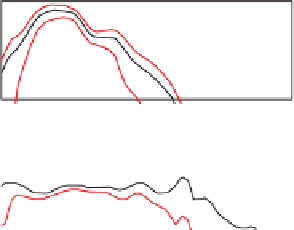Geology Reference
In-Depth Information
(a)
(b)
(c)
100
AI
Best
Seis
Syn
Well
Seis
200
-100
80
-60
60
-20
40
0
20
-200
20
ΔΥ
(m)
0
60
×
Well location
+
Selected trace location
100
(d)
Amplitude
0
-10
-20
100
0
-100
Frequency (Hz)
Figure 4.19
Exceptionally good well tie from a sequence with good seismic character.
properties and thicknesses. High data bandwidth and
good signal/noise are very important.
In contrast, there are other situations where there
is significant phase ambiguity, due to low bandwidth
and monotonous seismic character. Phase ambiguity
means that data can be tied equally well with wavelets
that have different phase and timing.
Figure 4.20
shows an example in which equally good ties can be
made with wavelets that have almost 90° phase differ-
ence. The main problem here is cyclical geology. Ties
can be made above and below this zone with much
less phase ambiguity.
the possible reasons for the mistie (such as structural
imaging), as well as the implied velocity changes, before
deciding to make adjustments.
Figure 4.21
shows an
example of a mistie that appears to be resolvable with a
simple stretch. The up-dip tie (
Fig. 4.22
)suggeststhat
the underlying problem lies in the migration of the
seismic data. In most instances reworking the migra-
tion is not an option so an ad-hoc solution is to change
the well location or apply a stretch. Either way, events
other than the two strong reflections tie quite poorly.
Of course, the quality of the checkshot data that
were used to construct the synthetic is a major factor.
If there are none, or if they are of dubious quality and
best ignored, then it would certainly be justifiable to
apply a stretch to the synthetic to allow for dispersion
effects on velocity between sonic and surface seismic
frequencies. Application of a squeeze would require
more justification, perhaps to account for poor log
quality. Where there are high-quality checkshots, per-
haps from a vertical-incidence VSP, it is still possible
4.6.2 Stretch and squeeze
A common reason for stretching and squeezing syn-
thetics is to generate background models for seismic
inversions so that the inversion results fit the well. The
interpreter needs a degree of scepticism about modify-
ing the depth
51
-
time relationship and should investigate




































































































